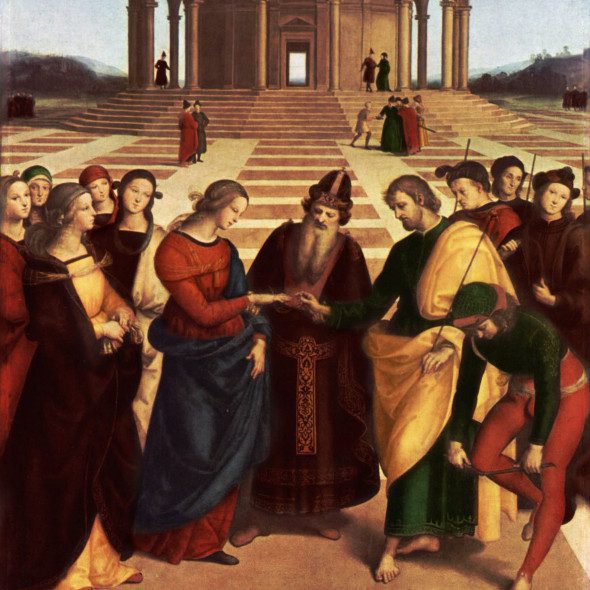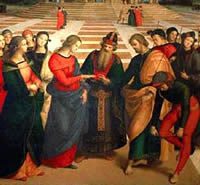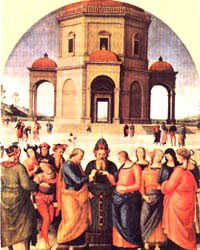La prima opera che Raffaello firma è Lo sposalizio della Vergine, commissionato dalla famiglia Albizzini per la cappella di San Giuseppe nella chiesa di San Francesco a Città di Castello. Il giovane urbinate, allora appena ventenne, si ispira all’opera omonima del suo maestro, il Perugino, opera che, trafugata in epoca Napoleonica, ora si trova a Caen, in Francia.
>>Vuoi visitare i luoghi del Perugino? Consulta ora le offerte dei migliori hotel nelle vicinanze di Città della Pieve.
Le analogie tra i due dipinti sono numerose; entrambi vengono realizzati con olio su tavola, la quale ha forma arcuata nella parte superiore. In primo piano i due artisti collocano i personaggi, al centro vi sono gli sposi con il sacerdote, dal lato dello sposo vengono posizionati gli uomini, mentre da quello della sposa le donne. Le due tavole sono tuttavia speculari, il Perugino colloca gli uomini a sinistra, mentre Raffaello li colloca a destra.

>> Ci sono offerte in scadenza per agriturismi nella zona di Città della Pieve! Clicca e consultale subito.
Sullo sfondo domina un tempio che si innalza su una scalinata. Tuttavia, mentre il Perugino realizza il suo tempio su una pianta ottagonale, con un pronao ogni due lati, che simboleggia la continuità fra l’antichità e la chiesa Cristiana, Raffaello predilige una soluzione diversa: dipinge un tempio con sedici lati, più vicino alla forma circolare e quindi più armonico, circondato da una peristasi di archi e colonne, che conferisce maggior ariosità all’edificio. Inoltre la scalinata su cui poggia il tempio di Raffaello è più alta e ciò contribuisce a dare maggior slancio alla costruzione. È probabile che Raffaello si fosse ispirato al Tempietto di San Pietro in Montecitorio del Bramante, di cui il pittore Urbinate aveva probabilmente visto i progetti. D’altronde i due artisti erano entrambi originari di Urbino e un particolare legame di amicizia legava il giovane Raffaello all’ormai anziano artista.
In entrambi i dipinti la prospettiva è realizzata creando una pavimentazione a scacchiera, meno decisa nel dipinto del Perugino, più marcata in quello di Raffaello. Inoltre in quest’ ultimo le linee prospettiche coincidono con gli spigoli della scalinata e dunque, sebbene parallele, sembrano snodarsi a raggiera, creando una sensazione di circolarità, in tema con la scelta del tempio a sedici lati. Un’ultima differenza fra le due opere la collocazione del punto di vista, posto all’altezza degli occhi dei personaggi nel dipinto del Perugino, leggermente spostato più in alto in quello di Raffaello: soluzione quest’ultima più moderna e efficace.
>>Se hai deciso di visitare i luoghi del Perugino ti consigliamo di contattare ora i b&b nelle vicinanze di Città della Pieve>> clicca questo link.
 The first work that was signed by Raphael is The Marriage of the Virgin. The young painter from Urbino who at the time is only twenty years old, takes inspiration from the work with the same name of his master Il Perugino.
The first work that was signed by Raphael is The Marriage of the Virgin. The young painter from Urbino who at the time is only twenty years old, takes inspiration from the work with the same name of his master Il Perugino.
There are several analogies between the two paintings: they are both realized with oil on board, which at the top is in the form of an arch. In the foreground the two artists put the characters. In the middle there are bride, bridegroom and the priest.
From the side of the maid the painters collocate the ladies, from the one of the bridegroom, the men. On the background a temple arising on a staircase dominates the scene. But while Perugino paints his temple with eight sides and with a pronao on every two sides which is a symbol of continuity between the ancient times and Christianity, Raphael decides himself for a temple with sixteen sides, a form closer to the circular one, and consequently more harmonic.
The temple is surrounded by a peristasis of arches and columns. Probably Raphael took inspiration from Bramante’s Temple of ST.Peter in Montecitorio. Considering that both the artists came from Urbino and there was a close frendiship between them, Raphael might have seen the project of the temple. Both the painters realize the perspective effect drawing the floor in a checkered pattern but Raphael uses stronger colors, Moreover in this last one the perspecive lines coincide with the corners of the staircase, so, despite of being parallel, the lines create a circularity sensation, coherently with the sixteen sides temple. A last difference between the two works is the collocation of the sight point, at the height of the eyes of the characters in Perugino’ s painting, a little above in Raphael one: a solution, the last one more modern and effecting.
 The first work that was signed by Raphael is The Marriage of the Virgin. The young painter from Urbino who at the time is only twenty years old, takes inspiration from the work with the same name of his master Il Perugino.
The first work that was signed by Raphael is The Marriage of the Virgin. The young painter from Urbino who at the time is only twenty years old, takes inspiration from the work with the same name of his master Il Perugino.
There are several analogies between the two paintings: they are both realized with oil on board, which at the top is in the form of an arch. In the foreground the two artists put the characters. In the middle there are bride, bridegroom and the priest.
From the side of the maid the painters collocate the ladies, from the one of the bridegroom, the men. On the background a temple arising on a staircase dominates the scene. But while Perugino paints his temple with eight sides and with a pronao on every two sides which is a symbol of continuity between the ancient times and Christianity, Raphael decides himself for a temple with sixteen sides, a form closer to the circular one, and consequently more harmonic.
The temple is surrounded by a peristasis of arches and columns. Probably Raphael took inspiration from Bramante’s Temple of ST.Peter in Montecitorio. Considering that both the artists came from Urbino and there was a close frendiship between them, Raphael might have seen the project of t
he temple. Both the painters realize the perspective effect drawing the floor in a checkered pattern but Raphael uses stronger colors, Moreover in this last one the perspecive lines coincide with the corners of the staircase, so, despite of being parallel, the lines create a circularity sensation, coherently with the sixteen sides temple. A last difference between the two works is the collocation of the sight point, at the height of the eyes of the characters in Perugino’ s painting, a little above in Raphael one: a solution, the last one more modern and effecting.
 The first work that was signed by Raphael is The Marriage of the Virgin. The young painter from Urbino who at the time is only twenty years old, takes inspiration from the work with the same name of his master Il Perugino.
The first work that was signed by Raphael is The Marriage of the Virgin. The young painter from Urbino who at the time is only twenty years old, takes inspiration from the work with the same name of his master Il Perugino.
There are several analogies between the two paintings: they are both realized with oil on board, which at the top is in the form of an arch. In the foreground the two artists put the characters. In the middle there are bride, bridegroom and the priest.
From the side of the maid the painters collocate the ladies, from the one of the bridegroom, the men. On the background a temple arising on a staircase dominates the scene. But while Perugino paints his temple with eight sides and with a pronao on every two sides which is a symbol of continuity between the ancient times and Christianity, Raphael decides himself for a temple with sixteen sides, a form closer to the circular one, and consequently more harmonic.
The temple is surrounded by a peristasis of arches and columns. Probably Raphael took inspiration from Bramante’s Temple of ST.Peter in Montecitorio. Considering that both the artists came from Urbino and there was a close frendiship between them, Raphael might have seen the project of the temple. Both the painters realize the perspective effect drawing the floor in a checkered pattern but Raphael uses stronger colors, Moreover in this last one the perspecive lines coincide with the corners of the staircase, so, despite of being parallel, the lines create a circularity sensation, coherently with the sixteen sides temple. A last difference between the two works is the collocation of the sight point, at the height of the eyes of the characters in Perugino’ s painting, a little above in Raphael one: a solution, the last one more modern and effecting.
 The first work that was signed by Raphael is The Marriage of the Virgin. The young painter from Urbino who at the time is only twenty years old, takes inspiration from the work with the same name of his master Il Perugino.
The first work that was signed by Raphael is The Marriage of the Virgin. The young painter from Urbino who at the time is only twenty years old, takes inspiration from the work with the same name of his master Il Perugino.
There are several analogies between the two paintings: they are both realized with oil on board, which at the top is in the form of an arch. In the foreground the two artists put the characters. In the middle there are bride, bridegroom and the priest.
From the side of the maid the painters collocate the ladies, from the one of the bridegroom, the men. On the background a temple arising on a staircase dominates the scene. But while Perugino paints his temple with eight sides and with a pronao on every two sides which is a symbol of continuity between the ancient times and Christianity, Raphael decides himself for a temple with sixteen sides, a form closer to the circular one, and consequently more harmonic.
The temple is surrounded by a peristasis of arches and columns. Probably Raphael took inspiration from Bramante’s Temple of ST.Peter in Montecitorio. Considering that both the artists came from Urbino and there was a close frendiship between them, Raphael might have seen the project of the temple. Both the painters realize the perspective effect drawing the floor in a checkered pattern but Raphael uses stronger colors, Moreover in this last one the perspecive lines coincide with the corners of the staircase, so, despite of being parallel, the lines create a circularity sensation, coherently with the sixteen sides temple. A last difference between the two works is the collocation of the sight point, at the height of the eyes of the characters in Perugino’ s painting, a little above in Raphael one: a solution, the last one more modern and effecting.





Comment (0)